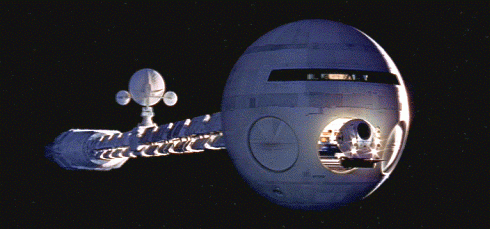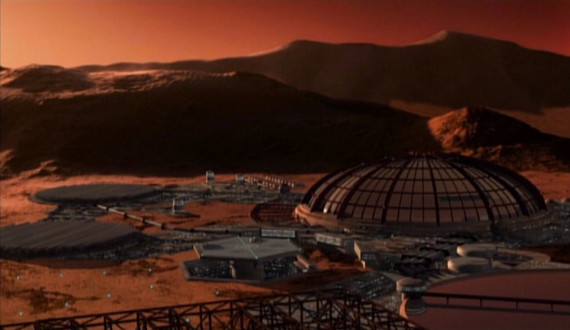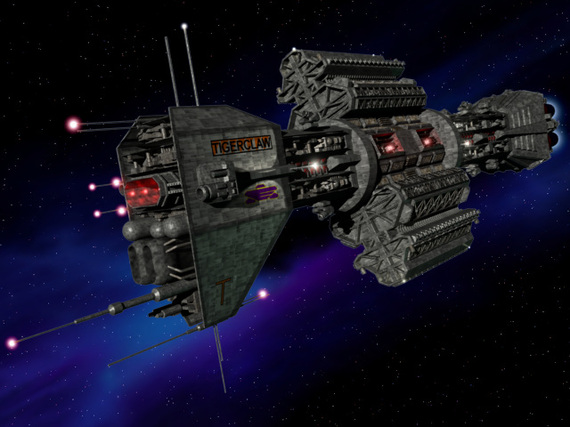Forget star travel! Let's get busy and really have some fun with our own back yard first!
One of my earliest introductions to how this would work comes from Robert Heinlein's wonderful books 'Red Planet' (1949), 'Between Planets' (1951) and 'The Rolling Stones' (1952) and 'Have Spacesuit. Will Travel' (1958). Heinlein's universe consisted of very large colonies on Mars and Venus, and settlements on Ceres, and Titan and the Galilean moons of Jupiter especially Ganymede. These were traditional domed communities that had matured into major settlements of upwards of 100,000 or more people. 'Red Planet' is set some time in the 21st century, with a major equatorial settlement and outlier colonies, and the beginnings of the terraforming process to make the Martian atmosphere breathable. Other stories like 'Podkayne of Mars' (1962) take place in the equivalent of 150,000-ton ocean liners (e.g. Queen Elisabeth II) in space that never touch down on a planet but where people are shuttled back and forth on self-propelled, aerodynamic ships. These leviathans maintain a constant acceleration of 0.1Gs so
interplanetary travel takes about a few weeks to get from Mars to Earth, and the ships rotate to produce Earth-like artificial gravity. In 'Have Spacesuit:Will Travel' we hear that a ship can reach Pluto in three weeks at a 1-G acceleration for half the trip and 1-G deceleration for the final half. Interplanetary travel appears to be with conventional 'reaction mass' rockets in 'The Rolling Stones' probably similar to V-2 rockets, and so there is some considerable 'magic' involved in the engine design. 
Interplanetary spacecraft from 2001:A space odyssey
Arthur C. Clarke's '2061:Odyssey three' (1987) shows us a solar system where travel times are also in weeks not years, with a colony on Mars and major lunar settlements numbering close to one million people. Passenger travel to Saturn is a reality, with ships under constant 0.1-G acceleration touring the solar system.
Reading between the lines
By the 23rd Century, the Babylon 5 universe (1995) created by J. Michael Straczynski has the Mars colonies seeking independence from Earth, two large lunar colonies, a station orbiting the Jovian moon Io ('Chrysalis') , as well as colonies on Ganymede ('Messages from Earth' ) and Europa ('TKO'). Travel from Io to Earth is several days by conventional ship with artificial gravity provided by rotation. Propulsion seems to be by ion engines powered by fusion reactors (e.g. Earthforce battle cruisers). Mars Colony at Syria Planum from Babylon 5
Mars Colony at Syria Planum from Babylon 5
In the Star Trek (1966) universe of the 24th Century, we hear about the Martian star ship design labs in the colony on Utopia Planitia (1987: Star Trek:Next Generation), and the population of the lunar colonies is about 50 million (Star Trek:TNG:A Time to Heal). The Mars Colonies seceded from Earth in the 22nd Century. Presumably travel times by 'impulse drive' (25% speed of light) are of the order of hours or days across the solar system using deuterium fusion reactors that eject plasma as reaction mass.
Roger MacBride Allen's The Ring of Charon (1990) is set in a solar system centuries in the future where there are colonies on the Moon, Mars, Venus, Mercury, Titan and Ganymede, along with a large gravity research station orbiting Pluto's moon Charon. It is 16 days to Earth from this outpost. Then we have Stephen Baxter's universe of 'Manifold Space' (2001) where we have a lunar colony but no outposts on Mars, however the technology needed for a 500-day trip to 1000-AU can be put into place very quickly once Humanity is motivated by alien invasion.
It's Cheap Folks!
The more you read science fiction, the more you realize we are doing something very wrong. Interplanetary travel is inherently inexpensive and is something that a mid-sized company or an ambitious explorer can afford. In the Heinlein Universe, it is relatively easy to get a decent rocket ship that even allows you to be self-sustaining for a year or more. Prices seem to be in the millions of dollars for a good ship that can get you to the asteroid belt. Miners become indentured to contracts to purchase these rockets, just as we have home mortgages to banks for our houses. If you want to step up to more luxury, in 'Enigma' (1986) written by Michael Kube-McDowell, you can purchase a 'spaceliner' capable of round trips to the Jovian moons for about a couple of billion dollars. These ships can make the trip to Jupiter in one month each way, and keep its passengers happy and well-fed!
No one ever talks about fuel!
For rockets, the most common design in science fiction, conservation of momentum demands that if you want to go forward fast, you have to throw something away in the opposite direction very fast. This is called reaction mass, and the whole point of engine technology development is to make the mass ejection speed as close to the speed of light as you can, so that you can carry less and less fuel (making the payload to rocket mass ratio as high as possible). Interplanetary travel in science fiction has mastered this using 'nuclear ion propulsion'. These engines are so efficient that the propulsion mass is a small fraction of the mass of the rocket...so it is hardly ever mentioned. Look carefully at the design of the Babylon 5 spacecraft...where are the hundreds of tons of reaction mass 'fuel' stored? How about the shuttle craft used in Star Trek? You don't store tons of reaction mass in those spiffy nacelles! And don't even get me started on Han Solo's Millennium Falcon, or Darth Vader's TIE-fighter! Where's the beef?
Earth Force ship with interplanetary capability, with no apparent reaction mass for the engines. (Credit:SpaceBattles.com)
So there you have it. In the next few centuries, we can colonize the solar system in any number of different ways using largely conventional technology extended to meet the reasonable challenges of week-long hope to Mars, Saturn or elsewhere. Without violating any known physics, ion engines already used on NASA's Dawn mission and many commercial satellites, along with solar sails combined with nuclear power plants (developed by NASA since the 1960s), can probably be scaled up to meet these challenges.
If only....
